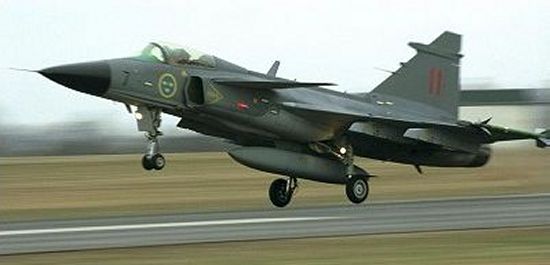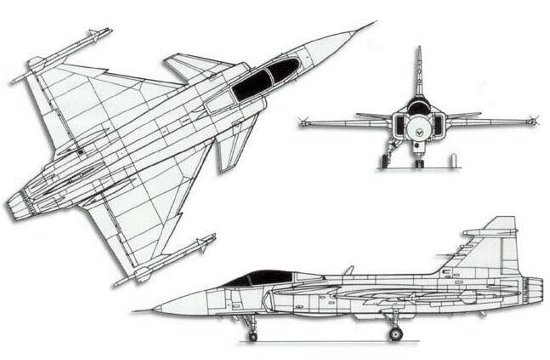|
||||||||||
|
|
||||||||||
|
||||||||||
|
|
||||||||||
 - -
|
|

|
Saab JAS 39 Gripen Multi-Role Fighter |
|
DESCRIPTION:
The Gripen was developed as a replacement for Sweden's aging Viggen and Draken fighters. While the Viggen family consisted of several individual models tailored to specific duties, the goal of the Gripen program was to develop a fully multi-role plane capable of performing an entire suite of fighter, attack, and reconnaissance missions. This philosophy was reflected in the designation JAS 39 for Jakt (Fighter) / Attack / Spaning (Reconnaissance). Responsible for the development of the Gripen is a consortium of Swedish companies called Industrigruppen (IG). This group includes Saab as the primary contractor, Volvo as engine developer, Ericsson with responsibility for the radar, and FFV Aerotech developing many avionics. The fighter's ambitious performance goals have been met thanks to several advanced technology features. The Gripen features a powerful engine and makes extensive use of lightweight composites to reduce overall weight. The Gripen also employs a delta wing and canard layout with saw-toothed leading edge slats and large elevon control surfaces. Together with a full-authority fly-by wire control system, this design gives the aircraft exceptional maneuverability and short-field performance. Further enhancing its combat effectiveness are the Gripen's multi-mode radar, nav/attack system, and multi-function cockpit displays. Although difficulties with the sophisticated control system and rising costs nearly led the Swedish parliament to cancel the program, the first Gripen was completed in 1987. Flight testing began in 1988, but disaster struck just two months later when the first prototype crashed. The problem was traced to software flaws that were only corrected after a major review by Calspan in the United States. Other issues with engine compressor blade cracking were also overcome, but the program was over three years behind schedule by the time the second Gripen prototype resumed flight tests in 1990. Once these problems had been rectified, the Gripen soon met or exceeded its requirements and has proven to be quite capable for its size. Initial production included the JAS 39A single-seat multi-role fighter as well as a two-seat trainer. Both models were delivered to the Swedish air force before production switched to the improved JAS 39C/D. Compared to the earlier models, these Gripen variants feature an increased maximum takeoff weight, uprated engine, new color cockpit displays, in-flight refueling capability, and compatibility with additional weapons like the Darter and Meteor air-to-air missiles. Saab hopes to further improve the aircraft with the Gripen Next Generation (NG) entering development. This model is to feature an active electronically scanning array (AESA) radar while also replacing the Volvo engine with a General Electric F414G offering up to 25% more thrust. The landing gear of the Gripen NG have been relocated to the wing freeing up considerable space in the fuselage for additional fuel tanks to increase range. A two-seat demonstrator of the NG model also carries two pylons on the fuselage compatible with heavy weapons like 2,000-lb laser-guided bombs. The Gripen has already proven a commercial success and has been ordered by five nations to date. Sweden is due to receive over 200 aircraft including 126 A and 50 C single-seat models as well as 14 each of the two-seat B and D versions. The first export customer was South Africa with an order for 17 JAS 39C single-seat fighters and nine JAS 39D trainers to replace the nation's Cheetah fleet. Hungary has also finalized a ten-year lease of a dozen JAS 39C fighters plus two trainers and plans to buy these planes once the lease period is completed. The same number of JAS 39C/D models have been purchased by the Czech Republic as well. The most recent order comes from Thailand for a total of twelve JAS 39C/D fighters. Additional export sales are being pursued through a marketing campaign aimed primarily at nations with aging fighters like the F-5 and MiG-21 in the same weight class as the Gripen. Countries that have expressed interest in the Gripen include Bulgaria, Switzerland, Croatia, Denmark, and Romania. The biggest potential sale is to India where the Gripen is competing against several European, American, and Russian fighters. Sweden is also attempting to sway Norway from a competing F-35 bid by offering to share development of the Gripen NG.
Last modified 02 May 2011
|
|
| HISTORY: | |
| First Flight |
(JAS 39-1) 9 December 1988 (JAS 39A) 10 September 1992 (JAS 39B) 29 April 1996 (JAS 39C) 14 August 2002 (Gripen NG) 27 May 2008 |
|
Service Entry
|
1 October 1997
|
|
CREW:
|
one: pilot
|
|
ESTIMATED COST:
|
$40 million
|
| AIRFOIL SECTIONS: | |
| Wing Root | unknown |
| Wing Tip |
unknown
|
| DIMENSIONS: | |
| Length |
(JAS 39A) 46.25 ft (14.10 m) (JAS 39B) 48.42 ft (17.76 m) |
| Wingspan | 27.56 ft (8.40 m) |
| Height | 14.75 ft (4.50 m) |
| Wing Area | 275 ft² (25.54 m²) |
|
Canard Area
|
unknown
|
| WEIGHTS: | |
| Empty |
(JAS 39A) 14,600 lb (6,620 kg) (JAS 39B) 17,635 lb (8,000 kg) |
| Normal Takeoff | 18,740 lb (8,500 kg) |
| Max Takeoff |
(JAS 39A) 27,560 lb (12,500 kg) (JAS 39C) 30,865 lb (14,000 kg) |
| Fuel Capacity |
internal: 5,000 lb (2,270 kg) external: unknown |
|
Max Payload
|
14,330 lb (6,500 kg)
|
| PROPULSION: | |
| Powerplant |
one Volvo Flygmotor RM12 afterburning turbofan (based on the General Electric F404-400) |
| Thrust |
12,140 lb (54 kN) 18,100 lb (80.51 kN) with afterburner |
| Fuel Type |
Jet A-1
|
| PERFORMANCE: | |
| Max Level Speed |
at altitude: 1,320 mph (2,125 km/h) at 36,000 ft (10,975 m), Mach 2.0 at sea level: unknown |
| Initial Climb Rate | 50,000 ft (15,240 m) / min |
| Service Ceiling | 50,000 ft (15,240 m) |
| Range |
typical: 860 nm (1,600 km) ferry: unknown |
| g-Limits |
+9.0 / -3.0
|
|
ARMAMENT: View a high-quality graphic of Gripen weapons load |
|
| Gun | one 27-mm Mauser Bk27 cannon |
| Stations | seven external hardpoints and two wingtip rails |
| Air-to-Air Missile | up to six AIM-9 Sidewinder (Rb74), up to four AIM-120 AMRAAM, up to four Rb72 Sky Flash, IRIS-T, A-Darter, Meteor BVRAAM |
| Air-to-Surface Missile | AGM-65 Maverick (Rb75), Rb15F |
| Bomb | GBU-10/12/16 Paveway laser-guided, Mk 82/83/84 GP, KEPD-350, DWS39 munition dispenser |
| Other |
rocket pods, recon pods, LITENING pod, ECM pods
|
| KNOWN VARIANTS: | |
| JAS 39-1 | First single-seat prototype lost in a landing accident two months after its initial flight; 5 total prototypes built |
| JAS 39A | Initial production single-seat multi-role fighter; 126 built |
| JAS 39B | Two-seat combat-capable trainer identical to the JAS 39A but lacking an internal cannon and with a reduced fuel capacity; 14 built |
| JAS 39C | Improved single-seat model with a more powerful engine, color cockpit displays, an optional retractable refueling probe, increased maximum takeoff weight, and compatibility with additional weapons and NATO equipment; 101 to be built |
| JAS 39D | Improved two-seat combat-capable trainer based on the JAS 39C; 29 to be built |
| JAS 39X | Designation for export models |
| Gripen NG |
Next Generation model proposed as a major upgrade to the JAS 39C/D, improvements are to include a more
powerful engine, increaed fuel supply for greater range, increased payload capacity, and an AESA radar;
1 two-seat demonstrator built
|
| KNOWN COMBAT RECORD: |
Libya - Operation Unified Protector (Sweden, 2011)
|
| KNOWN OPERATORS: |
Czech Republic, Cesk Letectvo a Protivzbusna Obrana (Czech Air Force and Air Defense) Hungary, Magyar Honvedseg Repülö Csapatai (Hungarian Air Defense Group) South Africa, Suid-Afrikaanse Lugmag (South African Air Force) Sweden, Svenska Flygvapnet (Swedish Air Force) Thailand, Kongtap Agard Thai (Royal Thai Air Force) |
|
3-VIEW SCHEMATIC:

|
|
SOURCES:
|
|


|
Aircraft | Design | Ask Us | Shop | Search |

|
|
| About Us | Contact Us | Copyright © 1997-2023 | |||
|
|
|||